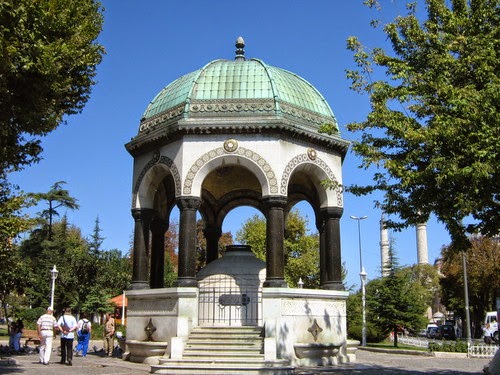A GERMAN FOUNTAIN IN ISTANBUL
The German Fountain is one of the many historic architectural monuments that make Istanbul a place one never tires of exploring.This frequently visited fountain on Sultanahmet Square is a virtual icon that draws tourists to have their picture taken in front of it.
The 19th century is remembered as a period of close relations between Germany and the Ottoman State.So much so that the German emperor,Kaiser Wilhelm II, visited Istanbul three times at different dates.On his second visit,when he was promised that the contract for the construction of the Istanbul-Baghdad Railroad would be given to German firms,he commissioned the building of a fountain,known as the German Fountain,as a gift to Istanbul and to the sultan.This fountain,from whose spouts water still runs today serving visitors to Sultanahmet,is also important for its architecture.
Work on the fountain began in the summer of 1899.Made entirely in Germany and shipped to Istanbul piece by piece to be assembled on Sultanahmet Square,the fountain was first going to be unveiled on September 1,1900,the 25th anniversary of Abdülhamid II' successionto the throne.But when the fountain could not be completed by that date,it was inaugurated instead on the Kaiser's birthday,january 27,1901.Thefountain inseription is a couplet by Ahmet Muhtar Bey, written in Thuluth script by Calligrapher İzzet Efendi.A bronze plaque at the entrance displays an inscription in German,saying.,'This fountain was commissioned in grateful memory of the visit of the German Kaiser,Wilhelm II, to the great Ottoman ruler,Abdulhamid II,in the autumn of 1898.
The German Fontain differs from both classical European public fountains and traditional public fountains in Istanbul.As a type,its design is closer to that of a shadervan (mosque fountain) than tahat of a public fountain.But the most striking aspect of the fountain are its solid columns of dark green porphyry,its ornamental arches,and its bright green,copper-plated dome.The cast-bronze bases and capitals of the columns exhibit relief designs consisting of stylizedvegatel motifs and alternating rows of four different patterns.Round medallions in high relief appear in the keystones of each of the semi-circular arches,whose edges are rimmed with a band of circular motifs with a central star.
The German Fountain,which was restored by the Fatih Municipality in 2013,continues to enhance the beauty of Istanbul with its ornamentation which employs no figurative motifs,its original design,its political and commemorative significance and,last but not least,its monumental quality.
The spouts on seven sides of the octagonal structure are still functional today.
.png)
























0 yorum: